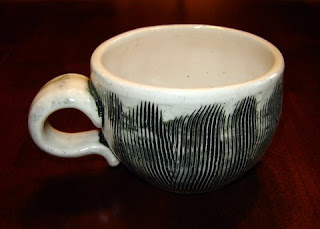I never really realized how small my kiln is. I got done unloading and thought, “Wow, there was hardly anything in there!” I knew my kiln wasn’t huge, but man, it is small! Now I’m always going to be self conscious about my kiln size. Actually, between the realization about my limited kiln space and its recent chicanery with glaze firings, this would be a good time to look into hooking up my “new” kiln. (My wife’s cousin recently moved and gave me all of his old pottery equipment, including a kiln and wheel!)


So here are the results. There were a couple of grow pots (planters), some tea bowls, a few mugs and a number of glaze tests. I was fairly pleased with how everything turned out, especially the toasty color of the clear glaze over the tea bowls. The color doesn’t come through too well in this picture, but it is nice…or at least I think so. I still have to go through all the glaze tests, but I think they will yield some good information.
 This is one of the mugs that I have been working on. It has a light underglaze wash and clear glaze on it. I have a few more that are textured like this, but I am not sure about finishing them the same way. Would a colored glaze be better? Do I need to do something with the handle? I don’t know. Any comments or suggestions would be more than welcome on this.
This is one of the mugs that I have been working on. It has a light underglaze wash and clear glaze on it. I have a few more that are textured like this, but I am not sure about finishing them the same way. Would a colored glaze be better? Do I need to do something with the handle? I don’t know. Any comments or suggestions would be more than welcome on this.And finally, the over firing issue. This load was over fired, but only slightly this time. I set up a witness cone so as I could keep an eye on it throughout the firing, but apparently I didn't watch it quite close enough. After running through the firing schedule for about seven hours the automatic shut off had not dropped on the kiln sitter, but the witness cone was bent so I turned it off. When I unloaded this morning some of the work was slightly warped, but not terribly so. And then there was this…
 You can see that the cone is bent slightly more than it should be (at least I think it is), but the bar for the kiln sitter is hardly bent at all! What?! So the question; is there a problem with the kiln sitter or did I somehow get a bad batch of bars? Both puzzling and frustrating.
You can see that the cone is bent slightly more than it should be (at least I think it is), but the bar for the kiln sitter is hardly bent at all! What?! So the question; is there a problem with the kiln sitter or did I somehow get a bad batch of bars? Both puzzling and frustrating.
Amigo, I have 3 kilns: a medium-ish and 2 REALLY small.
ReplyDeleteHave you heard this one? "It's not the size, but how you use it"......HAR!
Great work. Keep posting, stuff is looking GOOD!
it's a blessing and a curse... my kiln is bigger but then you have to wait until you can fill it to fire... exciting nevertheless
ReplyDeleteThe reason behind the difference in the melting between the bar and the witness cones.... Cones are the THING! Cones are the final end-all/be-all of determining when your glazes are perfect. So, if you call it cone 6 or whatever based on the CONE, then all is well. Bars and cones in sitters are there as a failsafe. They DO fail...on occasion. But more to the point, they are there so that when you space out and forget to check your witness cones you dont accidentally melt down your pots. So, for a cone 6 firing, we have cones 4-7 in a pack. Then we put a cone 7 in the sitter. It doesnt even sort of melt.
ReplyDeleteI know a lot of folks use sitters as a way of shutting a kiln off. That's not what they're for. Eventually they fail. Rest assured you'll have great firings if you're there to see your baby shut off right on time.
cheers and good firings!
-Alex @coldspringsstudio.com
Part of using cones successfully is using them to help you know where the hot and cold spots are in your kiln. Although I have a kiln sitter, I don't use it, I know when my kiln is done by the color of heat peeking out through the gap in the lid of the electric kiln. I know where to load what based on years of testing and messing around with cones to see where the kiln gets hot and where it doesn't. I'd recommend you use your cones to tell you where to put your stuff in your kiln, but not to determine when to shut off your firing. Using a pyrometer is a much better indicator. Julia
ReplyDelete